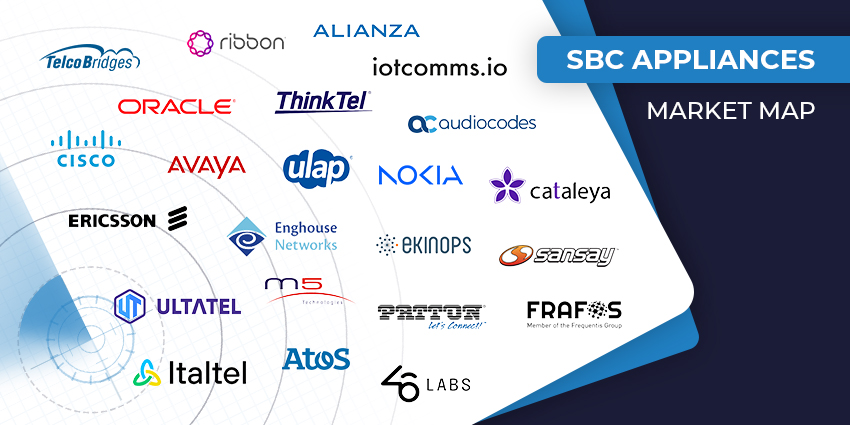The chances are you don’t think about your Session Border Controller (SBC) much, until it breaks. Then suddenly, the wrong calls are getting blocked, the right ones aren’t getting through, and your compliance officer is asking why recordings aren’t showing up.
In 2025, the top session border controller vendors are delivering solutions that accomplish more than ever. These systems make sure your Microsoft Teams calls stay encrypted. They translate protocols between whatever UC platforms you’ve got stitched together, and they catch suspicious traffic before it can cause damage.
Still, finding the right SBC vendor can be challenging. You don’t want to think about SIP normalization or signaling security. They just want voice that works, wherever their people are, and an audit trail you can trust. We’re here to help, with our objective insights into some of the best session border controller vendors worth watching this year.
The Top Session Border Controller Vendors
The Top Session Border Controller Vendors: SBC Showdown
Picture this: you’ve just rolled out a new UCaaS across half your company, but your SIP trunks still go through a legacy PBX.
Or maybe your hybrid workforce spans five countries, and you need voice experiences to be consistent everywhere. That’s where the top session border controller vendors matter most. They stop calls from falling apart and make sure your hybrid and multi-platform setups don’t break the bank or your SLA.
Now, let’s jump in. These best SBC providers are on our shortlist for a reason: flexible deployment, sharp integrations, smart security, and support that enterprises actually need.
AudioCodes
AudioCodes has been in the SBC space for ages, but they’ve managed to stay sharp. Their flagship Mediant line now comes in hardware, VM, and container versions, all running the same software core. That means whether you’re deploying in AWS, on-prem, or at the edge, you’re not managing wildly confusing stacks.
AudioCodes’ session border controllers are fully certified for Microsoft Teams and Direct routing, packed with advanced security features, and refreshingly easy to use. They also make SBC Wizards and SCOM tools for Teams Direct Routing for simple provisioning.
No matter the size or scale of your business, AudioCodes ensures every organization can find something that works for their communication needs.
Ribbon
Ribbon Communications is one of the top session border controller vendors supporting both enterprise users and service providers. Their SBC portfolio, which includes Core SBCs, Edge SBCs, and Cloud SBCs, covers everything from big SIP trunks to Teams Direct Routing.
Ribbon’s SBCs promise robust SIP security and interoperability for any deployment environment or location. They’re tested to work alongside Zoom, RingCentral, Microsoft Teams, and Cisco BYOC solutions. Additionally, they also include high-level security features for more highly regulated brands. Plus, everything plugs rapidly into DevNet-style APIs, so managing large fleets isn’t a chore.
Ribbon also offers plenty of resources for clients, whether you’re looking for tips on overcoming Direct Routing challenges.
TelcoBridges
TelcoBridges is one of the under-the-radar players that pops up regularly in SBC comparisons, and for good reason. Their ProSBC (and the free version, FreeSBC) runs on Linux, scales from hundreds to tens of thousands of sessions, and supports SIP/TLS and SRTP out of the box.
They released a big update in early 2025, adding GR‑303 support to their gateway line, which tells you they’re still focused on real-world interoperability. Plus, ProSBC is priced pay-as-you-go, which makes it easy to pilot. But it’s not just about price: it handles remote workers smartly, adapts to whatever SIP trunks and conferences you’re running, and it’s got reliability stamped all over it.
If you’re looking for extra assistance, TelcoBridges also offers a fully managed ProSBC+ service with round-the-clock technical support.
Thinktel
Thinktel is laser-focused on making Microsoft Teams voice work seamlessly, without the drama. Their Think365 Cloud Voice service bundles SIP trunking, direct routing, and an SBC into a neat, managed offer that’s built for speed. Setup’s quick, and you’re talking to real people when something needs tweaking.
Behind the scenes, Thinktel’s been certified for Teams Direct Routing for years, and their SBC setup is fully redundant, running out of geo-redundant Canadian data centers. You get full PSTN breakout, number portability, voicemail, and all the Teams voice features without needing to figure out Microsoft’s call policy maze yourself.
What makes them stand out is how straightforward the process is. No confusing pricing, no mystery integrations. They’re particularly popular with Canadian businesses, but their model works for any IT team that wants Teams voice rolled out without having to become a SIP expert overnight.
Oracle
One of the better-known names in any list of the top session border controller vendors, Oracle supports companies worldwide. The company’s SBC offering is built to enable connections between fixed-line, mobile, and IP interconnect solutions. Oracle offers STIR/SHAKEN client support, SIP trunking and hosted business services for enterprises, and even assistance with regulatory compliance requirements.
What’s notable is how deeply Oracle’s SBC ties into broader enterprise architecture. If you’re already using Oracle Cloud or running on Oracle’s telco stack, it slots in smoothly. It’s virtualized, container-ready, and works with Kubernetes for high availability setups. You can also run it on bare metal.
Oracle offers plenty of end-to-end support and guidance too, as well as specialist solutions for Microsoft Teams Direct Routing and Operator Connect.
Alianza
When Alianza acquired Metaswitch, a lot of people wondered what would happen to the Perimeta SBC. Turns out, it’s only gotten better. Perimeta is now fully software-based and tuned for service provider environments that want to go full cloud, but without losing the tight control you get from on-prem deployments.
One of the standout features is how Perimeta separates its signaling and media planes. That means you can route signaling through your cloud region of choice while handling media closer to the edge, reducing latency without blowing up your architecture.
It’s also tightly integrated into Alianza’s broader voice platform, which means you get a native path to cloud voice, contact center, or carrier-grade UCaaS without bolting together different tools. Teams Direct Routing support is built in, and real-time policy enforcement lets you control traffic flows with precision.
Cisco
Cisco doesn’t make much noise about CUBE, but it’s one of the most widely deployed SBC solutions out there. If you’ve already got IOS-XE gear in place, CUBE is practically built in, and it handles a surprising amount of session control without requiring an extra box or virtual machine.
Over the years, Cisco has added new features to its SBC system, like DNS-SRV prioritization, dual-stack IPv4/IPv6 support, and webhook-based telemetry. So now you can trigger automation scripts or update call analytics in real time.
CUBE also works well with Teams Direct Routing and Zoom Phone local survivability. It’s streamlined, intuitive, dependable, and integrates deeply with Cisco’s collaboration tools and voice infrastructure.
Avaya
Another of the top session border controller vendors with a long history in voice, Avaya combines flexibility, security, and reliability. The company’s Session Border Controller for Enterprise (SBCE) comes with built-in security features, high availability clustering, and NAT handling for mobile users.
Avaya SBCE also works well in hybrid setups, so if you’re transitioning from on-prem to cloud or trying to integrate with Microsoft Teams, it gives you some breathing room. The documentation is great, and there’s a solid admin community out there for support when you need it.
For companies in need of additional support, Avaya can also offer specialist services and guidance for connectivity and technology management.
Nokia
Nokia’s Core & Edge SBCs are built for telcos, but enterprises with performance needs will appreciate what comes with that pedigree. These SBCs sit at access edges handling signaling and media traffic for IMS, roaming, SIP trunks, and enterprise interconnects.
Recent updates strengthen TLS/SRTP encryption and add support for multi-tenancy in NFV clouds, handy for enterprise divisions or managed service providers spinning up separate environments. Their media anchor controls also reduce latency and packet loss, which is a big deal when your traffic is global.
Nokia’s SBC solution can be deployed either as a standalone solution or as part of the Nokia VoLTE/VoWiFi offering. Alongside secure and scalable technology, Nokia also offers access to network analytics through their SBC portfolio for SLA verification and QoE assurance.
Cataleya
Cataleya’s Orchid Link was built from the ground up for cloud-native deployments. This is an SBC that runs inside Kubernetes pods, auto-scales with load, and updates itself without interrupting calls Orchid Link supports Teams Direct Routing, Webex, and even acts as a WebRTC gateway. Their REST APIs make integration into CI/CD pipelines a breeze.
What really stands out is the embedded analytics, Orchid spots weird SIP behavior or burst traffic, and pushes alerts into Ops tools like Slack. That kind of anomaly detection gives you early warning of issues that could otherwise disrupt service .
The tools come with all of the standard security features today’s companies expect, as well as fraud analytics. Cataleya even offers a direct “Link2Teams” carrier peering and routing service for Teams users.
Ericsson
Ericsson’s Cloud IMS SBC is usually sold to carriers, but it deserves attention if your enterprise roadmap includes private 5G, VoLTE or VoWiFi. It handles signaling/media handoffs between LTE, Wi‑Fi, IMS and web RTC, all with carrier-grade muscle.
In 2025, they’ve rolled out tighter slice-aware signaling, SRTP optimization, and SIP-UA interworking, making it easier to deploy cross-network voice in the mobile core . It integrates with their broader Communication Services UDM suite, giving you telemetry on session quality and per-subscriber QoS.
If you’re building a private 5G network or deeper engagement with IMS, Ericsson’s SBC brings heavy-duty controls and future-proofing, complete with deep analytics and seamless scaling across multi-network domains.
Enghouse Networks
Enghouse’s Dialogic BorderNet SBC has built a reputation for reliability, especially in UCaaS and contact-center integrations. It handles Teams Direct Routing, SIPREC for recording, STIR/Shaken, WebRTC, TLS/SRTP, and transcoding all from a single code base.
As one of the top session border controller vendors, Enghouse embeds both real-time analytics and advanced security into SBCs. You can track all kinds of operational data, leverage built-in firewalls and DoS protection, and dynamically distribute processor loads based on insights.
SBCs are available as hardware, VM, or in AWS marketplace for SME edge use cases. Its balanced feature set and adaptability make it a solid choice for businesses wanting to simplify SBC deployment across hybrid environments.
Ekinops
Ekinops’ Compose platform offers a neat twist: SBC functionality built directly into their multi-service routers (OneSBC) or as VNFs (OnevSBC). That lets service providers or distributed enterprises combine routing, security, and session control in one box.
For companies scaling their Microsoft Teams strategy, Ekinops offers the secure OneAccess product line, which supports “bring your own carrier” strategies. All of the SBC options available are feature-rich, with hidden topology and NAT transversal media transcoding, extensive codec support and more.
Companies can leverage the Ekinops SBC solutions to streamline and secure global connections for both analogue and digital systems. The tools are offered with a “pay as you grow” model to ensure companies can freely grow and evolve over time. Here’s the latest news on Ekinops.
Sansay
Sansay’s VSXi is a workhorse of an SBC, effortlessly handling huge volumes and edge cases without fanfare. The system can manage up 500k simultaneous calls and a million SIP registrations, all from a software stack that runs on standard servers or in the cloud. Sources say it nails SIP trunk DDoS protection, protocol normalization, and NAT traversal.
Like many of the top session border controller vendors, Sansay is Microsoft Teams certified, so you can add their SBCs to your Direct Routing setups with ease. APIs let you script SIP trunk provisioning, great if you’re operating several instances or want automation baked in.
With built-in firewalls and leading security protocols, Sansay’s SBCs ensure peace of mind and flexibility. They can support local number portability, performance monitoring, and transcoding for fixed and wireless audio and video codecs.
ULTATEL
Ultatel zeroes in on Teams voice, and it shows. Their Microsoft-certified SBC and built-in calling plans come with AI tools for voicemail transcription, call sentiment, and quality scoring too.
They’ve unbundled prices cleanly: SBC-only at $2/month, or bundled plans at $10–26 depending on how much AI and PBX functionality you wan. Ops teams love that it installs into your tenant, ports existing numbers, and plugs into CRM systems. You can even customize chat features, groups, collaboration tools, and security policies.
If Microsoft Teams is your central hub and you need PSTN, AI insights, and full admin transparency in one package, Ultatel has a lot to offer.
ITALTEL
An Italian communications equipment and ICT company, ITALTEL offers digital workspace, hybrid cloud, 5G network, and data centre solutions for digital transformation. This company stands out as one of the top session border controller vendors for its NetMatch-S collection.
Companies get the kind of flexible, telco-grade kit you’d expect from a company rooted in telecom history. It’s virtualized, cloud-ready, and certified for both Microsoft Teams Direct Routing and Cisco Webex PSTN interconnects.
One exciting feature is multi-tenant slicing, which lets an SP host separate instances for different customers from a single virtual platform. Since it handles voice, video, and messaging across SIP/IP, it’s widely deployed in operator-style or neutral-host environments.
M5 Technologies
M5 Technologies blends small cell wireless and SBC smarts, aiming to simplify voice at the network edge. Their appliances are compact, rugged, and designed for retail locations, campuses, and venues that mix Wi-Fi, LTE, and VoIP.
The recent 2025 update added intelligent voice routing that picks the best network channel (Wi‑Fi, cellular, VoIP) for each call, based on real-time signal and load. That makes M5 a neat fit for distributed sites with unreliable network conditions.
Admins can manage everything via their cloud portal and get alerts via webhook if cell signal dips or call quality drops. If your teams work in remote shops, event spaces, or campus buildings, M5 offers a smart, resilient voice option.
Patton Electronics Co.
Patton’s session-border tech is built into their media gateway appliances, so it’s a seamless fit if you’re connecting legacy TDM voice, SIP, and IP. Their SmartNode SBCs offer TLS/SRTP, SIP normalization, encryption, and built-in NAT traversal.
Using the SmartNode solutions from Patton, companies can access in-built protection for VoIP connections, alongside load balancing and high availability ensured by stateful call failover. Patton even utilizes its own proprietary Trinity software for added security.
What stands out is simplicity. You plug the gateway into your network, configure signaling rules via a web UI, and you’re secure. It’s a good fit for organizations looking to bridge old and new systems without deploying heavy virtual or cloud infrastructure.
ATOS
ATOS takes a unique approach to maintaining its position as one of the top session border controller vendors. They focus less on standalone products and more on embedding SBC functionality into managed infrastructure, especially for regulated or complex enterprise environments.
Their SBC-as-a-Service offer rolls voice, SIP trunking, compliance, and session control into a broader managed UC stack. You won’t be downloading firmware or configuring TLS profiles yourself. ATOS handles provisioning, deployment, monitoring, and patching through its own global delivery teams. That includes setting up high-availability SIP routing across hybrid cloud environments and integrating with platforms like Teams and Cisco Webex.
What’s appealing here is that you’re not just getting a border controller, you’re getting ongoing support, governance, and enterprise-grade service management. This is particularly useful for multinationals trying to deploy consistent voice security policies across regions, without having to staff up internally or manage voice infrastructure piecemeal.
46 Labs
46 Labs is coming in hot with a different spin on SBCs: think less about hardware and more about clean, fast orchestration. Their core product, PeerEdge, is an SBC-as-a-Service platform that simplifies voice infrastructure through a fully virtualized control layer. It’s designed to run in any environment, and it’s deeply API-driven from the ground up.
They’ve packed a lot into this platform: intelligent routing, SIP normalization, media anchoring, and even billing triggers. But what really catches attention is their DevOps-friendly model. You can deploy SBC instances dynamically, scale on demand, and push real-time analytics into external dashboards via open APIs.
In early 2025, they launched a set of security features that include AI-assisted anomaly detection. That’s useful for catching fraudulent call behavior or sudden call-volume spikes before they impact service.
FRAFOS
FRAFOS competes with other top session border controller vendors with the “ABC SBC platform”. This solution was designed to address the requirements of service providers and operators migrating their VoIP infrastructure into the cloud. The system works well with virtualized environments and cloud solutions from leading vendors, with built-in security systems for peace of mind.
The SecunetSBC is the only SBC currently certified by the BSI to deliver the protection and security necessary for governmental institutions. It includes an integrated firewall solution and rigidized hardware for specific compliance requirements.
FRAFOS also offers a software-based WebRTC gateway solution, that can be used as a standalone system for flexible teams.
Iotcomms
Working with companies around the world, Iotcomms delivers tools to address several use cases. For companies investing in video and voice technologies, the company offers access to SBC solutions to establish secure connections between WebRTC and/or SIP devices.
The company’s Voice and Video Communication Platform includes embedded SBC functionality that handles signaling, routing, recording, and media security on the fly. That means end-to-end encryption, secure SIP transport, and full compliance with GDPR and local residency laws—baked into the infrastructure itself.
Companies can also use cloud PBX tools, call recording systems, IVR builders, and a comprehensive cloud communications environment, with built-in analytics.
ULAP
ULAP is one of those niche vendors doing really smart work in the SBC-as-a-Service space. They particularly appeal to organizations operating across Southeast Asia, Australia, and increasingly the UK and EU. Their whole pitch is simple: provision SBCs in minutes via a self-service portal, scale capacity instantly, and route voice traffic securely, all without managing infrastructure.
Their platform supports Direct Routing for Teams, Webex PSTN interop, SIP trunking, and full STIR/SHAKEN compliance. Plus, everything runs over encrypted media channels, and they offer cloud instances regionally, so your data stays close to home (and within regulatory bounds).
Lately, ULAP expanded local number support to 15 countries, upgraded their analytics layer, and added automatic call-path failover, so if one regional SBC drops, another one quietly picks up the load.
The Top Session Border Controller Vendors: Keep Your Voice Edge
If this list proves anything, it’s that the SBC market has officially grown up.
SBCs aren’t hardware appliances shoved in a rack to deal with SIP traffic. In 2025, the top session border controller vendors are delivering flexible, cloud-native, API-friendly, and deeply integrated solutions that fit into the way real companies actually work now: hybrid, global, and platform-diverse.
Some vendors still focus on the traditional enterprise perimeter. They’re helping Teams talk to legacy PBXs, or securing SIP trunks for a contact center rollout. Others are building infrastructure to run thousands of concurrent calls in a multi-tenant cloud, or to plug encrypted voice into alarm systems and field devices. The range is wider than ever.
If you’re still struggling to make the right choice, UC Today is here to help:
- Download exclusive research: Get the latest trends and vendor insights to guide your SBC investments and infrastructure decisions.
- Join the community: Connect with UC pros solving the same challenges and share your thoughts as part of the UC Community.
- See it in action: Attend live events and meet the vendors face-to-face. Put the tech to the test to see who you can really trust.
- Master your next purchase: Our Ultimate UC Buyer’s Guide walks you through every step, from initial analysis, to implementation.
Secure, scalable, and reliable voice is still crucial in the modern enterprise. Make sure you’re ready to grow, with the right tech and business insights.







